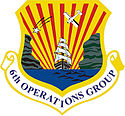6th Operations Group
| 6th Operations Group | |
|---|---|

Boeing KC-135R-BN Stratotanker 62-3552 assigned to the 6th Air Refueling Wing, 91st Air Refueling Squadron, at MacDill Air Force Base, Fla., flies a training mission over the Sunshine Skyway Bridge over Tampa Bay, Florida.
|
|
| Active | 1919–1948; 1951–1952; since 1996 |
| Country | United States |
| Branch | United States Air Force |
| Engagements | World War II |
| Insignia | |
| 6th Operations Group emblem |  |
The 6th Operations Group (6 OG) is the operational flying component of the 6th Air Mobility Wing, stationed at MacDill Air Force Base, Florida.
The mission of the 6th OG is the planning and executing global aerial refueling, combatant commander airlift, and specialized missions for US and allied combat and support aircraft. The group extends US global power and global reach through employment of a mix of KC-135R and C-37 aircraft.
The 6th Operations Group is a successor organization of the 6th Group (Composite), one of the 15 original combat air groups formed by the Army before World War II. During World War II, the 6th Bombardment Group (Very Heavy), was a B-29 Superfortress group assigned to Twentieth Air Force flying bombardment operations against Japan. Its aircraft were identified by a "R" inside a Circle painted on the tail.
The 6th Operations Group's origins begin on 30 September 1919 as the United States Army Panama Canal Department 3d Observation Group, being stationed at France Field in the Panama Canal Zone. The unit was a command and control organization of numerous miscellaneous light observation squadrons established by the Air Service to provide protection for the Panama Canal area.
In 1921 the group was redesignated the 6th Group (Observation) and in 1922, the 6th Group (Composite). The 6th flew such aircraft at the Curtiss R-4, DeHavilland 4-B, SE-5A, MG-3A, Piper L-4, P-12B and Martin B-10 and Douglas B-18 Bolo aircraft.
Throughout the 1920s and 1930 the group participated in maneuvers, flying patrol missions, photographing the canal area, staging aerial reviews and making good-will flights to Central and South America. In 1933, the group became part of the larger 19th Composite Wing, which provided a central command and control organization for the Air Service units. In 1937, as the mission of the 6th moved toward bombardment, the War Department renamed it the 6th Bombardment Group. They continued to operate in the Canal Zone under the VI Bomber Command of the Sixth Air Force at Rio Hato AB, Albrook Field and Howard Field.
...
Wikipedia
